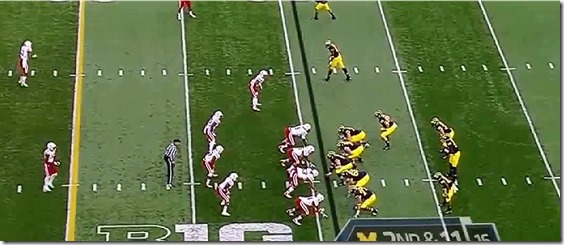ItP: Power O, Inverted Veer, and the FB Adjustment to Scrape Exchange
Introduction
In the picture pages post today, I feel I noted something of some significance. This isn’t supposed to be a post to puff out my own chest, rather, I merely want to give theother side of the argument my side of the argument for what it really is.
As an aside, there have been numerous people that have constantly misconstrued my argument lately. I understand that by taking a particular unpopular stance so strongly, that I have opened myself up to criticism. But within this article I also want to make clear up some of my stance, so towards the end I will get into some of that. Much of these will be related to the comments I made earlier (if not copy and pasted), the major difference is that I now have the opportunity to add accompanying pictures and diagrams to go with it. This is of importance because football isn’t really a sport that is best described with words. You can try to be as descriptive as possible, but there will always be a certain amount of failure to accurately convey your thoughts through this medium. So the pictures/diagrams help in that regard. So let’s begin.
Set Up and Play Design
I’m going to copy and paste Brian’s set up to his post as he does a good job getting us there.

I’ll get to the covered receiver part later, I want to start off with the basics here about what the intention of this play is. Let’s first start with the most fundamental concept of any run play: the blocking scheme.
Inverted veer works with a Power O blocking scheme. Power is a type of man/gap blocking scheme, while “O” indicates the pulling of the backside guard. A simple power play looks like this.

The inverted veer meanwhile, takes the fullback and erases him. It utilizes the option read to kick out the DE because the DE must commit to the QB or the RB. If the DE commits to the RB, the QB reads this and shoots through the lane inside of him. If the DE commits to the QB, the QB gives to the RB and the RB attacks the edge. Here’s how the inverted veer looks:

In the picture pages post today, I feel I noted something of some significance. This isn’t supposed to be a post to puff out my own chest, rather, I merely want to give the
As an aside, there have been numerous people that have constantly misconstrued my argument lately. I understand that by taking a particular unpopular stance so strongly, that I have opened myself up to criticism. But within this article I also want to make clear up some of my stance, so towards the end I will get into some of that. Much of these will be related to the comments I made earlier (if not copy and pasted), the major difference is that I now have the opportunity to add accompanying pictures and diagrams to go with it. This is of importance because football isn’t really a sport that is best described with words. You can try to be as descriptive as possible, but there will always be a certain amount of failure to accurately convey your thoughts through this medium. So the pictures/diagrams help in that regard. So let’s begin.
Set Up and Play Design
I’m going to copy and paste Brian’s set up to his post as he does a good job getting us there.
Michigan comes out with an H-back and two tailbacks in a twins formation, which necessarily means that the slot receiver is not an eligible receiver. Nebraska responds with 7.5 in the box, with the gray area defender just about splitting the difference between Funchess and the tackle.

I’ll get to the covered receiver part later, I want to start off with the basics here about what the intention of this play is. Let’s first start with the most fundamental concept of any run play: the blocking scheme.
Inverted veer works with a Power O blocking scheme. Power is a type of man/gap blocking scheme, while “O” indicates the pulling of the backside guard. A simple power play looks like this.

The inverted veer meanwhile, takes the fullback and erases him. It utilizes the option read to kick out the DE because the DE must commit to the QB or the RB. If the DE commits to the RB, the QB reads this and shoots through the lane inside of him. If the DE commits to the QB, the QB gives to the RB and the RB attacks the edge. Here’s how the inverted veer looks:

* * * * * * *
To learn about how the inverted veer and power blocking scheme adjusts to a 6i technique, and how a FB is utilized within the inverted veer framework to counter the scrape exchange, follow the link to MGoBlog



Comments
Post a Comment